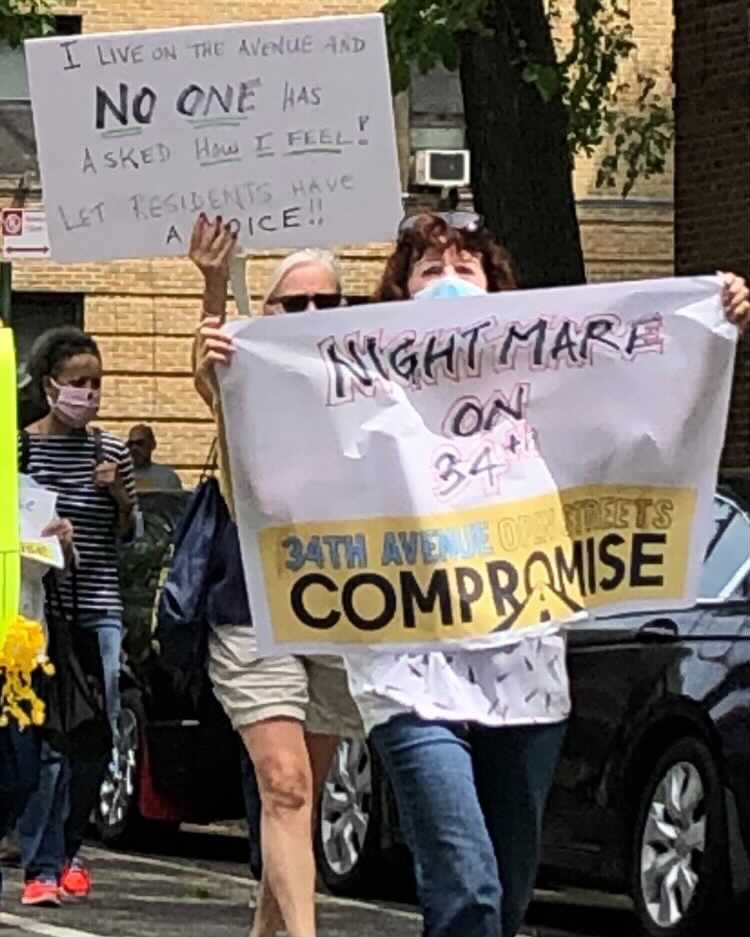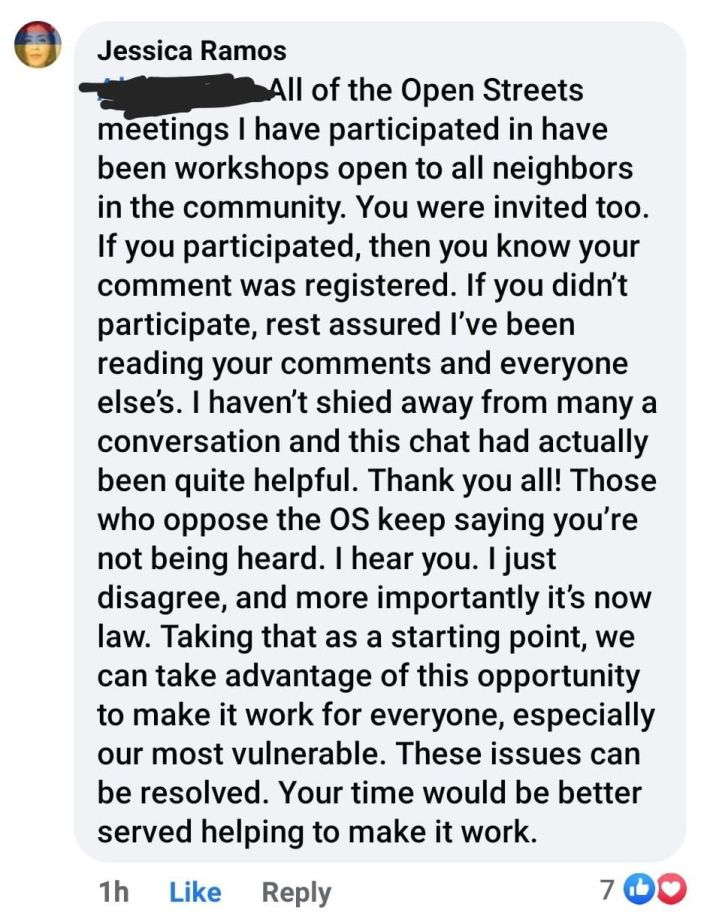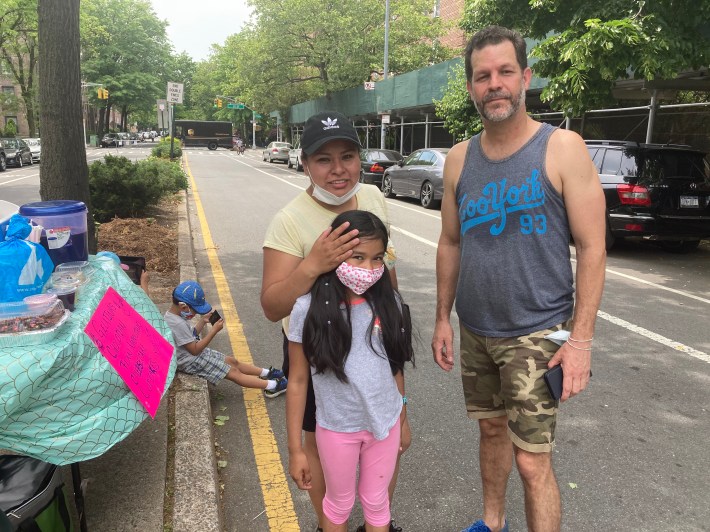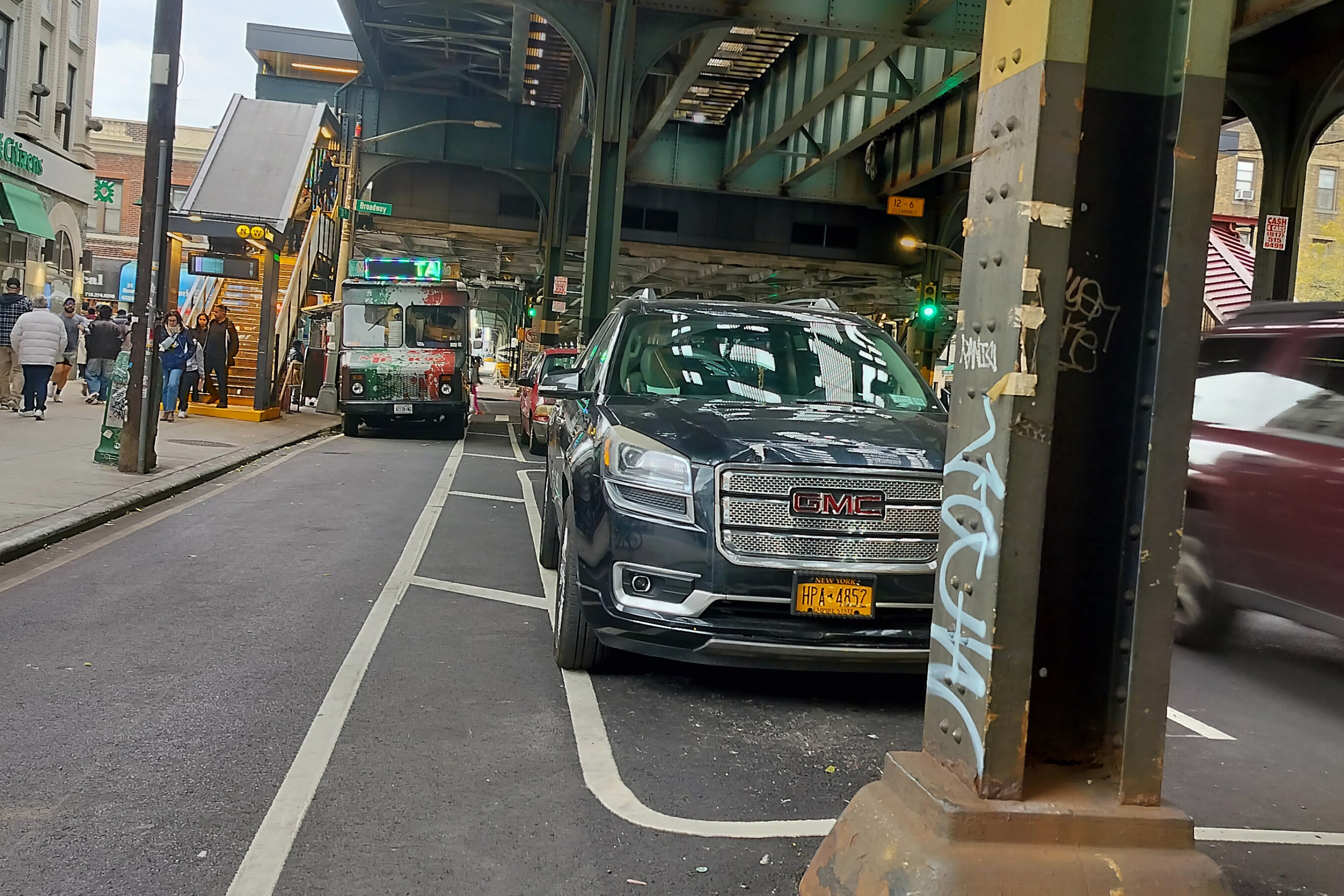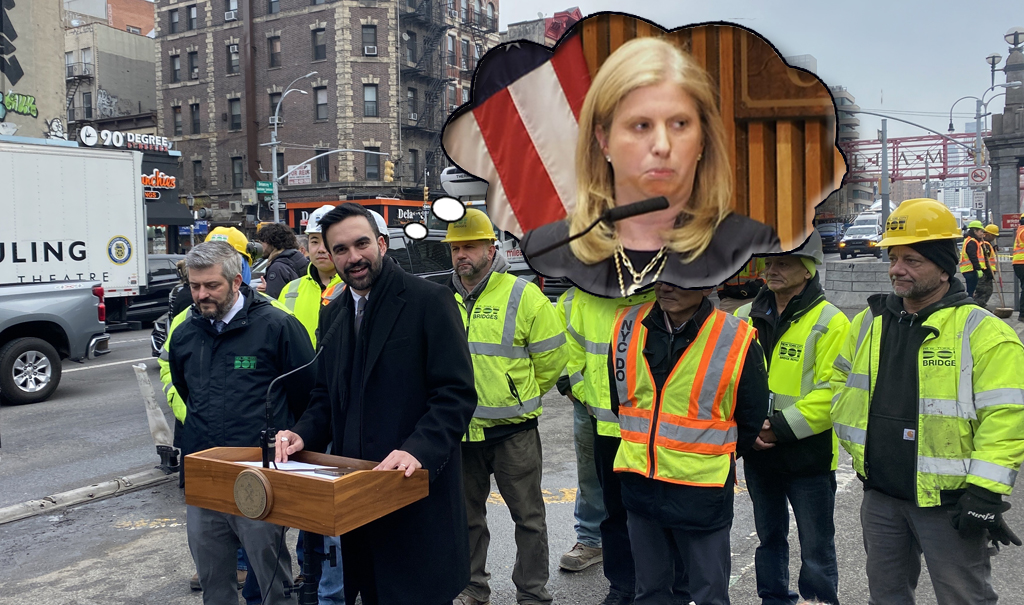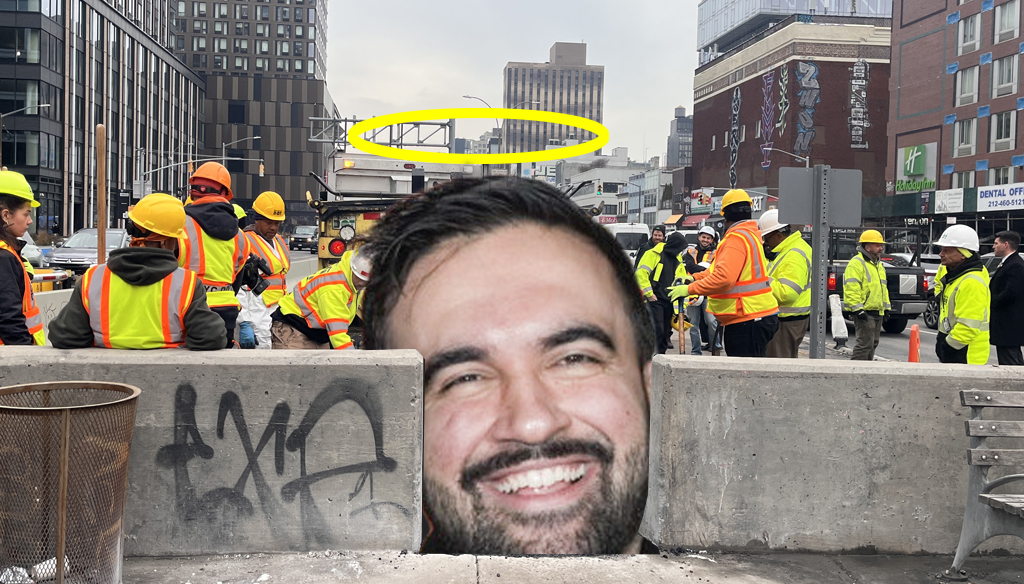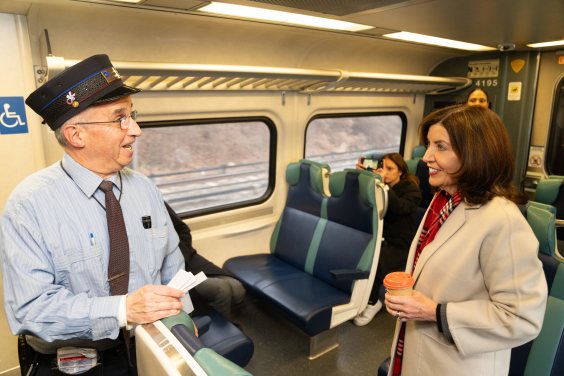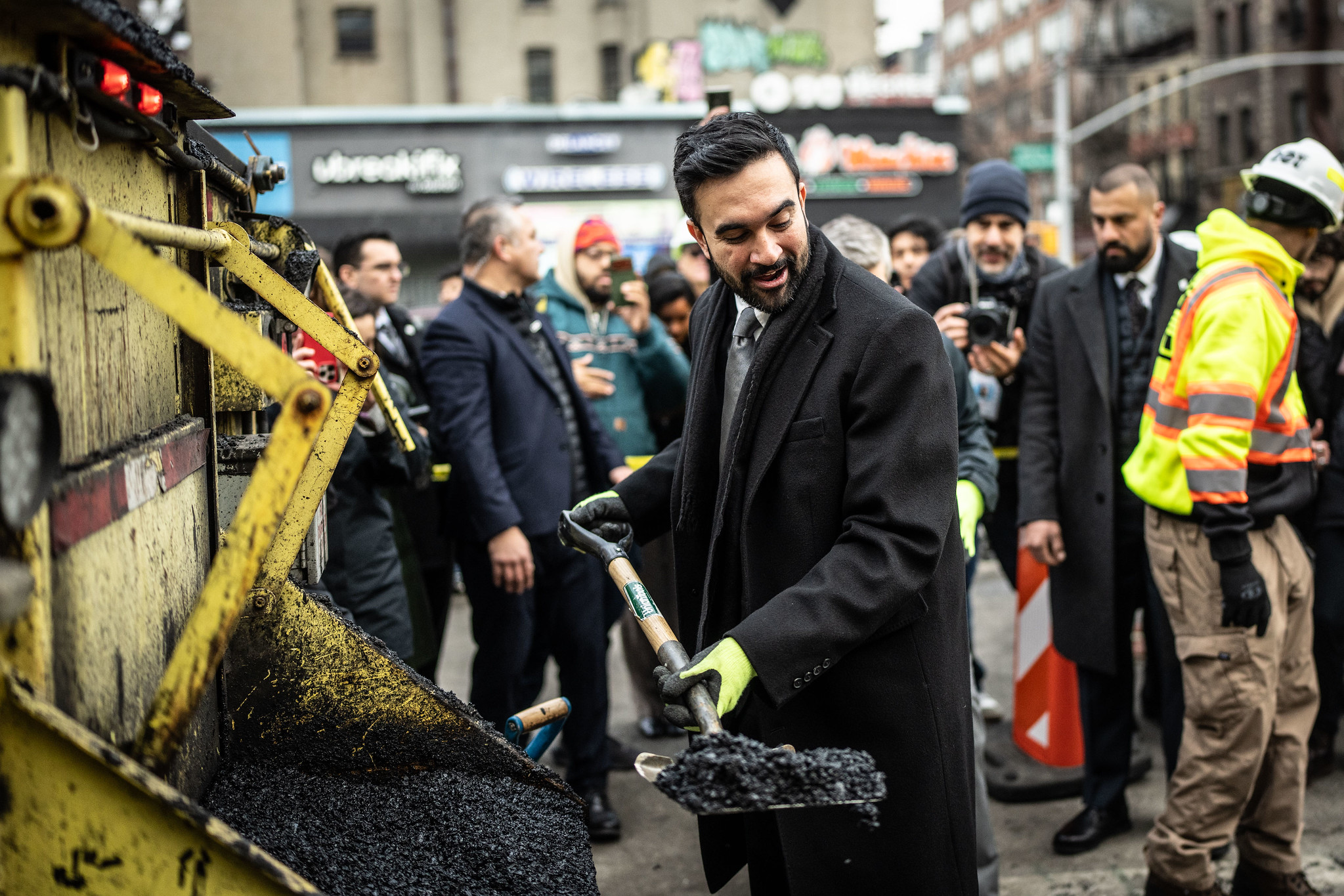Roughly 100 people on Saturday safely marched down the 34th Avenue open street in Jackson Heights, demanding a so-called “compromise” that seeks to reduce the hours and days of the very open street that the group was using for a protest march that passed dozens more people enjoying the open space.
Organizers of the group, 34th Avenue Open Streets Compromise, insist that they are not trying to kill the open street entirely, but are merely informing residents and soliciting feedback about what locals want to see for the street. But the group’s main asks are that the open street be shortened in length — it currently spans just 1.3 miles from Junction Boulevard to 69th Street — and be reduced from its current seven days a week, 12 hours a day to something that provides less safety and greenspace for a neighborhood that was a COVID epicenter partly because of its historic lack of open space.
At the @34Compromise rally to reduce the hours of the open street here in Jackson Heights, where locals are gathering safely in the open street pic.twitter.com/Ca0UdFlXsL
— Julianne Cuba (@Julcuba) May 22, 2021
The group also started a petition that seeks to ban vendors (whose activities are legal under city law), limit social activities on the open street (which are also a part of the city's recently passed law mandating permanent open streets), and allow unrestricted traffic on one side of the avenue (where it is currently limited to 5 miles per hour during open streets hours).
“We would love to do a study to know what times and what areas of the open street are used the most to focus on those areas and times instead of doing the whole stretch and 12 hours a day, which could actually complicate things,” said Paola Peguero, who lives on 34th Avenue. The Department of Transportation is already conducting such a study, and there are also at least two Streetfilms documentaries on the subject). Peguero also claimed that there is additional congestion on side streets and that people are not getting deliveries, which DOT has also debunked.
"This is a residential avenue," she added. "It's unfair for people ... when this was imposed on them."
Their demands are in direct opposition with another group, Friends of 34th Avenue Linear Park, which wants to transform the previously car-choked roadway into a “linear park” in hopes of:
- creating the maximum amount of new green space
- maximizing safety
- providing access to existing driveways and garages
- facilitating access for emergency vehicles, delivery, city services, and school buses
- accommodating people with disabilities, including Access-A-Ride
- expanding space for public schools to use for programs
- reducing conflict between pedestrians, cyclists, and motorists.
And that group's petition has more than 1,000 signatures so far, organizers have said.
DOT officials have called 34th Avenue “the gold standard” of what an open street should be, but have thus far been mute about what the agency's plans are for carrying out the recently passed legislation requiring permanent open streets (the DOT is expected to present a plan next month). DOT officials have repeatedly met with anti-open street activists — including a recent meeting at which two DOT staffers were berated for an hour — yet anti-open streets activists continue to say their "voice" is not being "heard."
Those limited anti-open street voices are, in fact, being heard. State Senator Jessica Ramos, who originally advocated for the 34th Avenue open street and previously told Streetsblog that she wanted it to be 24-7, broke her month-long silence on the issue to respond to opponents on Facebook.
"Those who oppose the OS keep saying you're not being heard. I hear you. I just disagree, and more importantly it's now law," she posted on a public Jackson Heights Facebook page. "Taking that as a starting point, we can take advantage of this opportunity to make it work for everyone, especially our most vulnerable. These issues can be resolved. Your time would be better served helping to make it work."
As Ramos suggested, solvable problems such as trash and making sure vendors are operating in legal areas, are being addressed in the ongoing public process that will culminate at the community board next month. But lost in the rage expressed by the anti-public space group — one woman held a sign reading, "Nightmare on 34th Avenue," as if 1.3 miles of recreation space was a horror move — is the fact that neighbors actually love the open street. The DOT's online survey conducted over the winter showed that respondents — 93 percent of whom live directly next to the open street — like having this new community resource.
Only 3 percent of survey respondents said, “I dislike the open street."
Meanwhile, 76 percent said their enjoyment of their neighborhood increased since the creation of the open street. Seventy-seven percent (that’s 1,600 people) said they wanted 34th Avenue to become a permanent “pedestrian and/or cycling priority corridor.”
Rossy Lopez, who was out on 34th Avenue selling homemade cupcakes and cakes with her kids, is one of them.
“I enjoy it with my kids,” said Lopez. “Sometimes when I’m walking I see a lot of old people and I say, ‘Hello’ in the morning. I’m feeling good when everybody talks with each other."
If it weren’t for the open street that was created during the height of the COVID-19 pandemic to allow for socially distanced recreation — especially in a district that has among the lowest amount of public green space — Lopez would never have met her neighbor, Maximo Rodriguez, with whom she’s become friends.
“Before, I don’t know who my neighbors were. When I started walking in the pandemic, I see a lot of people,” said Lopez, who lives on 34th Avenue and doesn’t own a car.
Rodriguez, who also lives on 34th Avenue, agreed, and said that’s why he loves the open street and wants to see it be made permanent (and he owns a car).
“I never spoke to her six months ago, but now we are friends because the street is open and we had the opportunity to be together like a community. People come here to walk and enjoy and meet each other, this is for everybody. I am the one who planted all the flowers last year,” he said. “You see people protesting and they are the first ones to enjoy the open street. This is for everybody. We enjoy it.”
Organizers of the 34th Avenue Open Streets Compromise insist that their motive isn't about cars or parking, and that they don't want to eliminate the open street entirely — but that's not what those who were actually marching behind them said.
One woman used coded anti-homeless and anti-vendor language in her contradictory argument for eliminating the open street.
“We’re not against it. 'Compromise' and 'against it' are two different things," said the woman, who declined to give her name. "There are many people in the march who I’m sure are against it, as I am, however I can see compromise. Right now there is no compromise. First of all, don't get rid of parking. Now you're going to have benches, vendors. Vendors sell food, food means an increase in the population of rats and insects. Benches mean you may have people who are coming here who want to lie down, and street drugs, loud music. Who is going to police this? We don't need vendors selling hot dogs.”
Others who oppose the open street made the argument that there is not enough parking in the neighborhood, though free on-street parking for each person who buys a car is not required under city law. But the open street is.
Census data show that residents who own cars in the greater Jackson Heights and Corona area — comprised by Community Board 3 — are far wealthier than their non-car-owning neighbors. According to the Census, the median income of a household without a car is $42,761, or roughly $25,000 less than the neighborhood’s median income. Households that own one car have a median income roughly 60 percent higher, or $68,214. And households with two cars have median incomes that are 170 percent higher than the non-car owners, or $115,140.
Another car-owner protesting the open street actually compared 34th Avenue in Jackson Heights to communist Cuba.
“What are we gonna do with our cars? We’re becoming like a communist country. You can’t have a car, can't do this, can't do that," said Louise Ross. "I live on 34th. People sit on our property and let their kids run amok. I come down because I can't stand the screaming."
Group members frequently claim they are not opposing the open street because of their car ownership. But in a poll conducted on the compromise group's private Facebook page (seen by Streetsblog), 76 percent of respondents said they own a car, which is far higher than the neighborhood's rate of 49 percent of households.
And not only would the reduction of the open street be a loss for vendors, but also for local kids who can now safely play and ride their bikes without fear of cars. The number of crashes dropped by 80 percent when the open street hours are in effect, Streetsblog revealed exclusively.
“We like it forever. We play soccer here. Every day. I live here,” said one teenager, who declined to provide his name, riding by with a friend. "We’re just out here riding our bikes usually. It's really fun here. This is what I look forward to everyday. I love this area and I'll honestly be devastated if they open it."
Many will.
New Yorkers of all races and income levels tell pollsters that their lives are better when car traffic is reduced around them. For instance, in a recent survey of likely voters commissioned by Streetsblog from the respected polling firm Data for Progress, we learned the following:
- 67 percent of voters said the city was right to close some roadways to traffic to create space for restaurants and people. The support was strong across the board:
- 66 percent of voters making less than $50,000 and 67 percent of voters making more than $150,000 agreed.
- 64 percent of Latino voters agreed (versus only 23 percent who didn't)
- The support was also strong in all age groups.
- 72 percent of voters say they prefer "livable streets that prioritize people's needs and their safety."
- The number rose to 77 percent among Black or African-American voters.
- And 72 percent of voters support livable streets in all income levels.
What is even more interesting is the racial breakdown of that survey. The overwhelming majority of voters who identified themselves as Latino or Hispanic support open streets (and, indeed, a majority — nearly 58 percent — of the people who live in Census blocks that straddle 34th Avenue identify as Hispanic or Latino). No matter how Streetsblog asked the question, we received largely the same answer from these voters, as the charts below show:
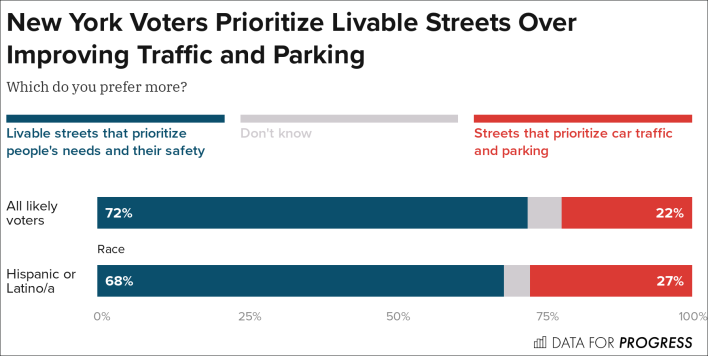

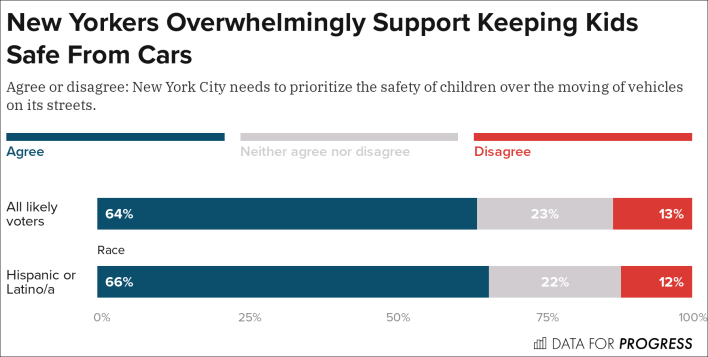
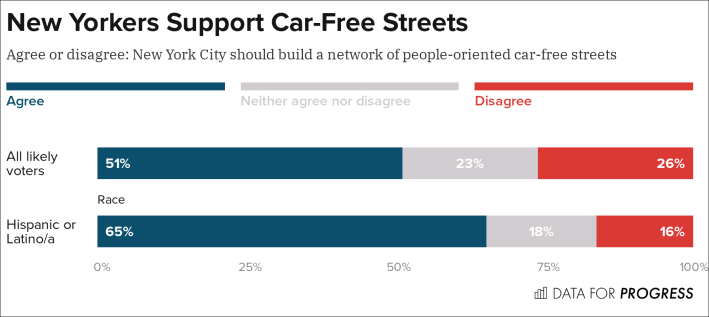
And, more important, the 34th Avenue open street has earned the broad support of the borough president, the neighborhood’s Assembly member and Council member, one of the candidates to succeed that Council member, and every day residents — all of whom have penned op-eds for Streetsblog.
And in an interview with Streetsblog on Friday, one day before the so-called compromise rally, mayoral candidate Kathryn Garcia reiterated her support for the open street — and her strong opposition to the “compromise” of reducing its hours or days or length.
“Thirty-fourth Avenue is lovely; it really is a community amenity now,” she said. “You see little kids on roller skates, kids on bikes, particularly in an area that has so little access to recreational activity. It’s is the right direction for us to be going in. … I want it permanent. I like having it closed to traffic, open to people all the time. That is the direction we want. I would not reduce their hours, I think it’s been incredibly successful.”
